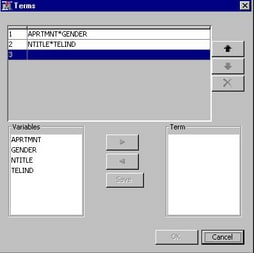Dialog Controls
Text Editor
The most common example
of a text editor
Dialog Control is
the Notes editor that is common to all SAS
distributed nodes. The notes editor simply provides a text file in
which the user might enter notes related to a particular node in a
particular process flow diagram. This capability was extended to extension
nodes in SAS Enterprise Miner 6.1. The XML Property configuration
for a Property with a text editor Dialog Control is
as follows:
<Property name="Code" displayName="Text Editor"
description="Example of a text editor which enables
you to enter and modify text in an external file."
type="String">
<Control>
<Dialog
showValue="N"
allowTyping="N"
class="com.sas.analytics.eminer.visuals.
CodeNodeScoreCodeEditor">
<Option name="key" value="CODE"/>
</Dialog>
</Control>
</Property>
First, notice the
class attribute
of the Dialog element. You must copy that
value verbatim. Second, notice the Option element.
The Option element has two attributes: name and value.
The name attribute has a value of "key"
and the value attribute has a value of "CODE".
This is simply a different syntax for declaring that this Dialog Control has
a key="CODE". The explanation for
why the syntax for this type of control is different from all the
other controls that have a key attribute is beyond the scope of this
discussion.
Registering the key
this way informs SAS Enterprise Miner that the text that the user
enters into the editor is to be stored in a file named CODE.sas. When
property="Y",
the contents of the editor are copied along if you use a cut-and-paste
action to make a copy of the node. When property="N",
the contents of the editor are not preserved if you use a cut-and-paste
action to make a copy of the node. No other server code is required
for this type of Dialog Control.
The user can then enter
any text that they want in the editor. When the user clicks OK,
the file is saved under the name CODE.sas in the extension node's
directory for that particular process flow diagram. For example, if
the projects directory is
c:\emprojects and
the project name is "extension nodes", then CODE.sas is
created in c:\emprojects\extension nodes\Workspaces\EMWS\EXMPL.
Similarly, you can create
a text editor
Control element that saves
as a .txt file instead of a .sas file. To do so, use the following
XML code:
<Property name="Code" displayName="Text Editor"
description="Example of a text editor which enables
you to enter and modify text in an external file."
type="String">
<Control>
<Dialog
showValue="N"
allowTyping="N"
class="com.sas.analytics.eminer.visuals.
GenericCodeEditorDialog">
<Option name="key" value="DESC"/>
<Option name="saveextension" value="txt"/>
<Option name="colorcode" value="N"/>
</Dialog>
</Control>
</Property>
Interactions Editor
When developing statistical
models, it is common to include interactions between explanatory variables
in your model. For example, if you have the variables A and B, their
interaction is written A*B. An interaction editor provides a way for
a user to manually construct a collection of interactions that can
be used by your extension node.
The XML Property configuration
for a Property with an interactions editor
Dialog Control is
as follows:
<Property type="String" name="Interaction" displayName="Interactions Editor" description="Example of an Interaction Editor."> <Control> <Dialog showValue="N" allowTyping="N" class="com.sas.analytics.eminer.visuals. InteractionsEditorDialog" > <Option name="Key" value="INTERACTION"/> <Option name="MainEffect" value="N"/> <Option name="MaxTerms" value="2"/> <Option name="Open" value="openInteractionTable"/> <Option name="Close" value="closeInteractionTable"/> <Option name="IntervalVariable" value="N"/> </Dialog> </Control> </Property>
The
class attribute
of the Dialog element uniquely distinguishes
this Dialog Control from
the other type of Dialog Control elements
and must be copied verbatim. Each of the Option elements
has two attributes: name and value.
These Option elements and their attributes
determine the interactions editor's capabilities.
The first
Option element
has a name attribute of "key" and
the value attribute has a value of "INTERACTION".
This is simply a different syntax for declaring that this Dialog Control has
a key="INTERACTION". The explanation
for why the syntax for this type of control is different from all
the other controls that have a key attribute
is beyond the scope of this discussion.
In the second
Option element, name="MainEffect" and value="N".
This indicates that the interactions editor is not to create an interaction
that consists of just a main effect. That is, all interactions must
include at least two terms. If value="Y",
then an interaction can consist of a main effect. That is, an interaction
can consist of a single term.
In the third
Option element, name="MaxTerms" and value="2".
This indicates that the maximum number of terms that can be included
in an interaction is 2. The value attribute
can have a range between 2 and 6.
The third and fourth
Option elements
represent an alternative syntax for the Actions elements
that appeared in other Control elements.
You must have at least one of these Option elements.
You can write server code that is associated with the name that you
provide in the value attribute of these Option elements,
but it is optional. The explanation for why the syntax for this type
of control is different from all the other controls that have Actions elements
is beyond the scope of this discussion.
In the final
Option element, name="IntervalVariable" and value="N".
This indicates that interval variables should not be used to populate
the list of variables from which the interactions are generated. When value="Y",
interval variables can be included in the list.
%em_register(key=INTERACTION, type=DATA); data &em_user_interaction; length key 8 Term $32; stop; run;
The first line of code
registers the key that appears in the first
Option element
in the example XML above. The DATA step programming generates an empty
data set that has two variables: a numeric variable named key and
a string variable named Term.
Finally, before the
interactions editor can be populated with variable names, there must
be a data source node preceding your extension node in the process
flow diagram. For example, suppose you have the following process
flow diagram:
When the user clicks
the  icon next to the interactions editor property the
following window appears:
icon next to the interactions editor property the
following window appears:
 icon next to the interactions editor property the
following window appears:
icon next to the interactions editor property the
following window appears:
When the user constructs
interactions, saves them, and clicks OK,
SAS Enterprise Miner creates the Emws.Exmpl_interaction data set.
For example, suppose the user had selected APRTMNT and GENDER for
the first interaction, and NTITLE and TELIND for the second interaction,
as depicted above. When the user clicks OK,
Emws.Exmpl_interaction appears as follows:
Copyright © SAS Institute Inc. All rights reserved.



